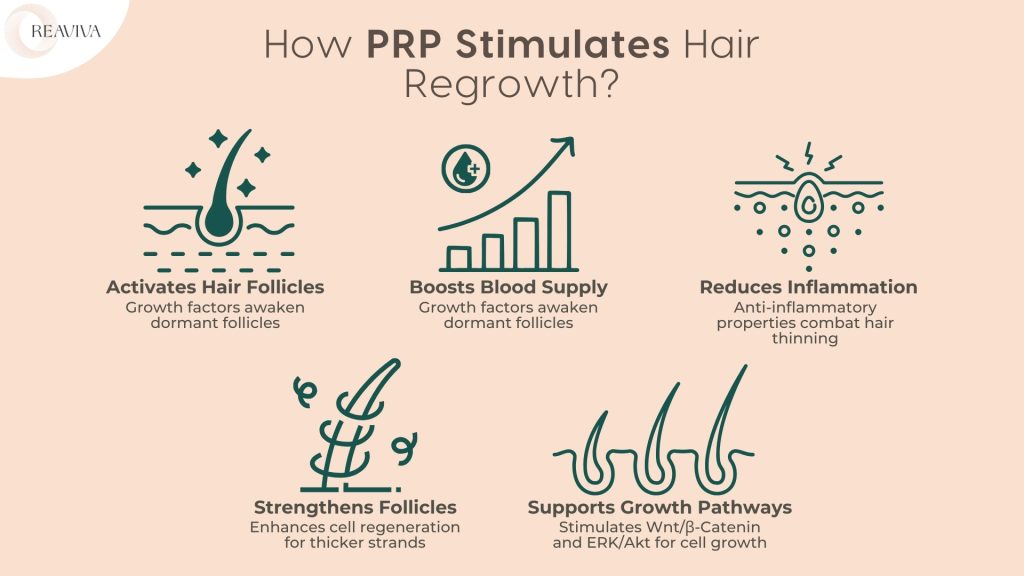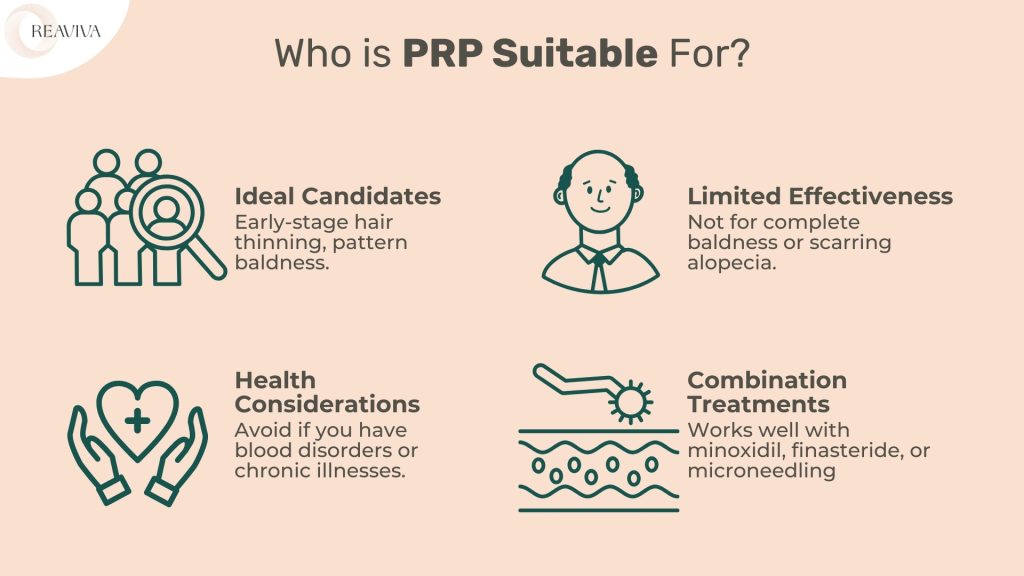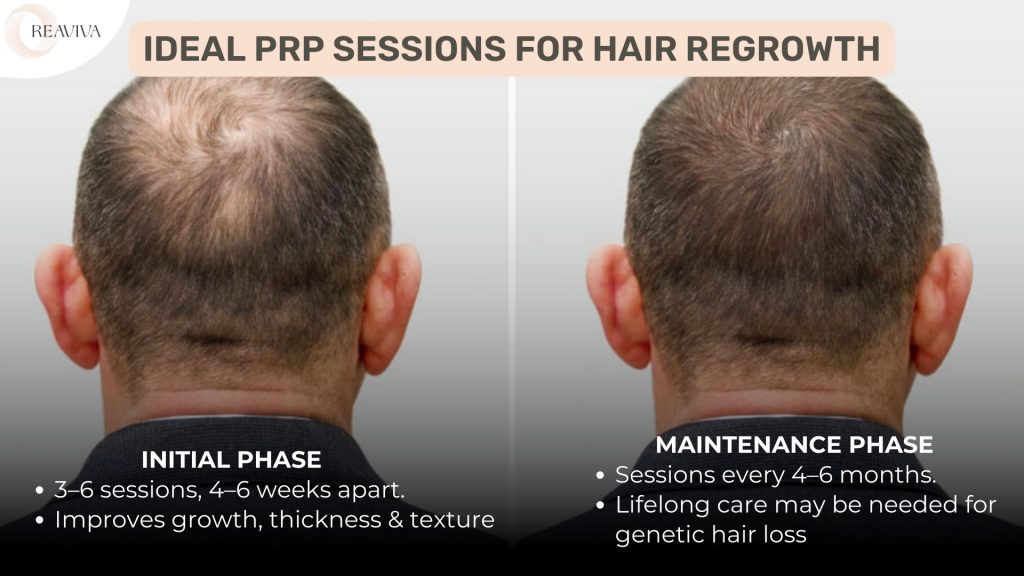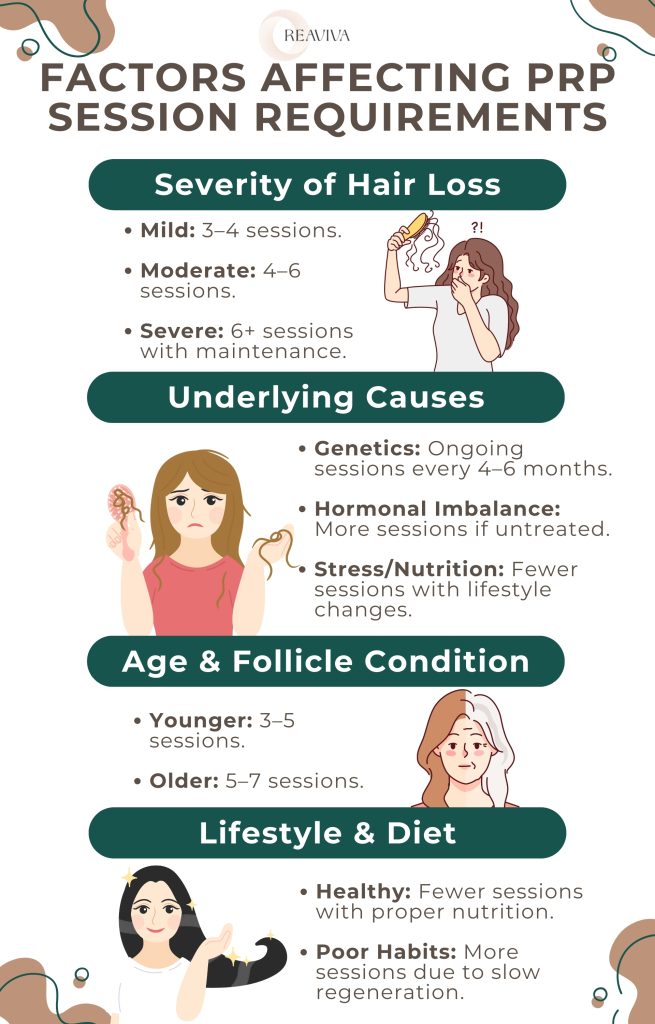Table of Contents
Losing hair can be frustrating and make people feel less confident. One treatment that has become popular is Platelet-Rich Plasma (PRP) therapy. This is a simple, non-surgical procedure that uses a person’s own blood to help hair grow back stronger and thicker.
Many people wonder: How many PRP sessions do I need to see results? The answer depends on a few things, like how much hair loss a person has, the reason for the hair loss, and how their body responds to the treatment. Some people notice a difference after just a few sessions, while others need more sessions to get the best results.
In this guide, we’ll explain what affects the number of PRP sessions needed, how long it takes to see changes, and important things to know before trying PRP therapy for hair growth.
How PRP Works for Hair Growth?
Hair loss is a concern for many, and PRP (Platelet-Rich Plasma) therapy has emerged as a natural, non-surgical treatment aimed at stimulating hair follicles and promoting regrowth. PRP is derived from the patient’s own blood, processed to concentrate platelets and growth factors, and then injected into the scalp to enhance follicular health and hair regeneration.
Understanding PRP Process

PRP therapy works by utilizing the body’s own healing properties. Here’s how the process unfolds:
- Blood Extraction & Preparation – A small blood sample (15-30 mL) is drawn from the patient.
- Centrifugation Process – The blood is spun in a centrifuge to separate platelet-rich plasma from red blood cells and other components.
- Activation (Optional) – Some protocols activate PRP with calcium chloride or thrombin to enhance growth factor release.
- Injection into the Scalp – PRP is carefully injected into areas with thinning hair, often paired with microneedling to improve absorption and scalp penetration.
How PRP Stimulates Hair Regrowth?

- Activating Hair Follicles – Growth factors like PDGF, VEGF, and EGF stimulate dormant follicles, pushing them into the growth (anagen) phase.
- Boosting Blood Supply – VEGF (Vascular Endothelial Growth Factor) promotes blood vessel formation, ensuring oxygen and nutrients reach the follicles.
- Reducing Inflammation – PRP contains anti-inflammatory properties that help counteract conditions that contribute to hair thinning.
- Strengthening Follicles – It enhances cellular regeneration, which protects and prolongs the anagen phase, leading to thicker, healthier strands.
- Supporting Key Signaling Pathways – PRP stimulates pathways like Wnt/β-Catenin and ERK/Akt, which play essential roles in cell proliferation and hair follicle survival.
Who is PRP Suitable For?

PRP therapy in Mumbai is a versatile treatment, but its effectiveness varies based on several factors:
- Ideal Candidates – Best results are seen in individuals experiencing early-stage hair thinning, particularly those with androgenetic alopecia (pattern baldness).
- Limited Effectiveness – PRP is less effective for people with complete baldness or scarring alopecia.
- Health Considerations – Individuals with blood disorders, autoimmune conditions, or chronic illnesses should consult a medical expert before undergoing PRP.
- Combination Treatments – Many patients combine PRP with minoxidil, finasteride, or microneedling for enhanced outcomes.
The Ideal Number of PRP Sessions for Hair Regrowth
If you’re considering PRP (Platelet-Rich Plasma) therapy for hair loss, one of the first questions you’ll likely have is: How many sessions do I need? The answer depends on several factors, including the stage of hair loss, your body’s response to treatment, and long-term maintenance. Below is a structured breakdown of what you can expect.

Initial Treatment Phase: 3–6 Sessions for Best Results
- Most patients need 3 to 6 sessions, spaced 4–6 weeks apart to kickstart hair regrowth.
- PRP stimulates dormant hair follicles, promoting new growth and improving hair thickness over time.
- Studies suggest that visible improvements in density and texture typically begin appearing after 3–4 sessions.
| Severity of Hair Loss | Recommended Sessions | Frequency |
| Early-stage thinning | 3–4 sessions | Every 4–6 weeks |
| Moderate hair loss | 4–5 sessions | Every 4–6 weeks |
| Advanced hair loss | 5–6 sessions | Every 4–6 weeks |
Maintenance Phase: Keeping the Results Long-Term
- Hair loss is often progressive, meaning ongoing care is necessary.
- After completing the initial treatment, maintenance sessions every 4–6 months help sustain results.
- For patients with genetic hair loss (androgenetic alopecia), lifelong maintenance may be required.
| Hair Condition | Maintenance Frequency |
| Mild hair thinning | Every 6–12 months |
| Moderate thinning | Every 4–6 months |
| Severe hair loss | Every 4 months |
What Factors Influence the Number of PRP Sessions?

PRP isn’t a one-size-fits-all treatment. The ideal number of sessions depends on:
- Age – Younger individuals often respond faster, requiring fewer sessions compared to older patients with weaker follicle vitality.
- Severity of Hair Loss – More advanced hair loss may require more frequent treatments to see noticeable improvement.
- Underlying Conditions – Hormonal imbalances (like PCOS or thyroid disorders) or autoimmune conditions (like alopecia areata) can impact response to PRP.
- Lifestyle & Health – Smoking, poor nutrition, and chronic stress may reduce PRP’s effectiveness, leading to additional sessions.
Why Multiple Sessions Are Necessary?
Hair follicles follow a natural growth cycle (anagen, catagen, telogen). PRP helps by:
- Prolonging the anagen (growth) phase of hair follicles.
- Enhancing blood circulation in the scalp for better oxygen and nutrient supply.
- Boosting follicle strength to prevent excessive hair shedding.
Can PRP Be Combined with Other Treatments?
Yes! Many dermatologists recommend combining PRP with minoxidil, finasteride, or low-level laser therapy (LLLT) for enhanced results.
PRP therapy offers a promising, non-surgical option for hair regrowth, but it requires commitment and maintenance to achieve lasting results. Consulting with Reaviva’s board-certified dermatologist or trichologist ensures you receive a personalized treatment plan tailored to your specific hair loss condition.
What are the Factors That Affect PRP Session Requirements?
When considering PRP (Platelet-Rich Plasma) therapy for hair loss, one of the most important things to understand is that the number of sessions you need depends on multiple factors. PRP isn’t a one-size-fits-all solution your results will vary based on your hair loss severity, underlying causes, age, and lifestyle. Let’s break it down.

1. Severity of Hair Loss
- Mild Hair Loss – If hair follicles are still active and responsive, 3–4 initial sessions (spaced 4–6 weeks apart) may be enough to stimulate regrowth.
- Moderate Hair Loss – Thinning hair with some dormant follicles may require 4–6 sessions to achieve noticeable improvement.
- Severe Hair Loss – Advanced hair thinning (especially with miniaturized follicles) may need 6+ sessions, with additional maintenance to sustain results.
| Severity of Hair Loss | Recommended PRP Sessions | Session Frequency |
| Mild | 3–4 sessions | Every 4–6 weeks |
| Moderate | 4–6 sessions | Every 4–6 weeks |
| Severe | 6+ sessions | Every 4–6 weeks + maintenance |
2. Underlying Causes of Hair Loss
Understanding why hair loss is happening can also influence how many PRP sessions you’ll need.
- Genetics (Androgenetic Alopecia) – PRP can slow down hair loss, but since it’s a progressive condition, maintenance sessions (every 4–6 months) are typically necessary.
- Hormonal Imbalances (PCOS, Thyroid Issues) – PRP works best when paired with proper hormonal management. The number of sessions may increase if the root cause isn’t addressed.
- Stress or Nutritional Deficiencies – Hair loss caused by stress (telogen effluvium) may respond faster to PRP, requiring fewer sessions if lifestyle changes are made.
3. Age & Hair Follicle Condition
- Younger Patients – Typically see results faster due to healthier follicles and better regenerative ability. 3–5 sessions may be enough.
- Older Patients – Hair follicles become less responsive with age, requiring 5–7 sessions for noticeable improvement.
4. Lifestyle & Diet
Your overall health can affect how well PRP works for you:
- Healthy Lifestyle – A diet rich in vitamins, minerals, and proteins (like biotin, iron, and vitamin D) enhances PRP effectiveness, potentially reducing the number of sessions needed.
- Poor Lifestyle Choices (Smoking, Stress, Alcohol) – Can impair follicle regeneration, meaning more PRP treatments may be required.
There’s no universal answer to how many PRP sessions you need it depends on your hair loss severity, health factors, and how well your body responds to the treatment. Consulting Reaviva’s board-certified dermatologist or hair restoration expert is key to getting a personalized plan that delivers the best possible results.
What is the Expected Timeline & Results for PRP Hair Treatment?
If you’re thinking about PRP therapy for hair loss, you’re probably wondering: When will I start seeing results? The answer isn’t instant PRP works in sync with your natural hair growth cycle, so improvements happen gradually. Let’s break it down so you know what to expect.

Phase 1: The First Few Months (1–2 Months)
- What’s Happening? – At this stage, PRP is kickstarting the healing process. The growth factors are working, but you won’t see much change yet.
- Mild Sensations? – Some people feel slight tingling in the scalp, which is totally normal.
- Shedding Alert! – A little extra hair fall might happen as weaker strands are pushed out. Don’t panic it’s actually a sign that new, healthier hairs are preparing to grow.
Phase 2: The Turning Point (3–6 Months)
- Less Shedding! – You’ll likely notice fewer hairs falling out in the shower or on your brush.
- Baby Hairs Appear! – Around month 3 or 4, tiny, fine hairs may start appearing in previously thinning areas.
- Stronger, Fuller Hair! – By month 6, existing hair feels thicker and healthier, making a visible difference in scalp coverage.
| Timeline | What to Expect? |
| 1–2 months | Healing begins, possible mild shedding |
| 3–4 months | Hair shedding reduces, new hairs emerge |
| 5–6 months | Noticeable hair thickening and strength |
Phase 3: Maximum Impact (6–12 Months)
- Fuller Look! – By month 6, hair appears denser and thicker, with noticeable improvements in scalp coverage.
- Peak Growth! – The best results happen between 9 to 12 months, as the follicles continue to strengthen and produce healthier strands.
- Hair Quality Boost! – Not just density PRP also improves hair texture and durability, making it look shinier and healthier.
| Month | Hair Growth Stage |
| 6 months | Stronger, healthier hair strands |
| 9 months | Thickened scalp coverage |
| 12 months | Peak results, best volume & texture |
Phase 4: Maintenance for Lasting Results
- Why Maintenance Matters? – PRP isn’t a one-and-done solution. Without ongoing care, hair thinning could return.
- How Often? – Most experts recommend a session every 6–12 months to keep results going strong.
| Hair Condition | Maintenance Frequency |
| Mild Thinning | Every 6–12 months |
| Moderate Thinning | Every 4–6 months |
| Severe Thinning | Every 4 months |
PRP works, but patience and consistency are key. If you stick with the plan, expect to see noticeable changes by 3–6 months and full results by 12 months. And to keep those gains? Regular maintenance is your best friend!














